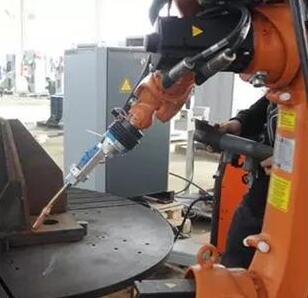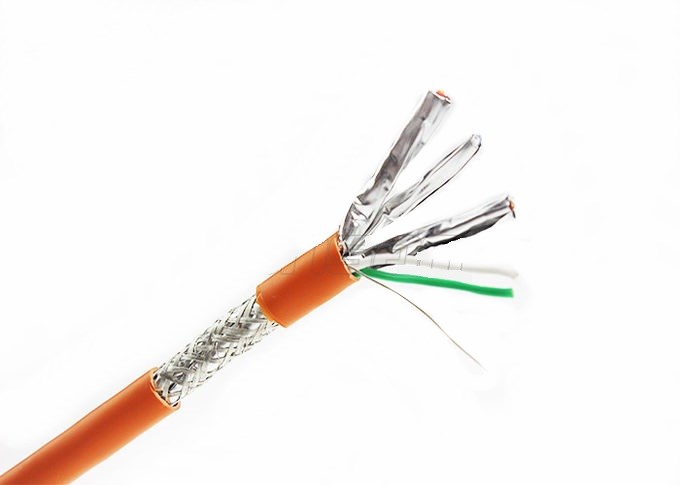Welding robots are industrial robots that are engaged in welding, including cutting and painting. According to the definition of a standard welding robot by the International Organization for Standardization (ISO), an industrial robot is a versatile, reprogrammable Manipulator with three or more programmable axes for Industrial automation field.
In order to adapt to different purposes, the mechanical interface of the last axis of the robot, usually a connecting flange, can be fitted with different tools or end effectors. The welding robot is to attach a welding tong or a welding (cutting) gun to the end shaft flange of an industrial robot, so that it can be welded, cut or thermally sprayed.

(1) The occurrence of a rifle may be due to a deviation in the assembly of the workpiece or an inaccurate TCP of the welding torch. The assembly condition may be checked or the welding torch TCP may be corrected.
(2) An arc fault occurs and the arc cannot be induced. It may be because the welding wire is not in contact with the workpiece or the process parameters are too small, the wire can be manually fed, the distance between the welding torch and the weld be adjusted, or the process parameters can be adjusted appropriately.
(3) Protective gas monitoring alarm. If there is a problem with the cooling water or the shielding gas supply, check the cooling water or the shielding gas line.
Welding robot common problems(1) There is a problem of weld bias: it may be that the position of the weld is incorrect or there is a problem when the weld gun is looking for. At this time, consider whether TCP (the position of the torch center point) is accurate and adjust it. If this happens frequently, check the zero position of each axis of the robot and recalibrate it to correct it.
(2) There is a problem of undercut: the welding parameters may be improperly selected, the angle of the welding gun or the position of the welding gun may be incorrect, and may be adjusted appropriately.
(3) Porosity problems: It may be that the gas protection is poor, the primer of the workpiece is too thick, or the shielding gas is not dry enough, and the corresponding adjustment can be processed.
(4) Excessive spattering problem: the welding parameters may be improperly selected, the gas composition may be caused, or the outer elongation of the welding wire is too long. The power of the machine may be appropriately adjusted to change the welding parameters, and the gas proportioning instrument may be adjusted to adjust the proportion of the mixed gas. Adjust the relative position of the torch to the workpiece.
(5) An crater problem is formed after cooling at the end of the weld: when the program is added, the buried crater function is added to the work step, which can be filled.

(1) Select a reasonable welding sequence to reduce the welding deformation and the length of the torch travel path to determine the welding sequence.
(2) The space transition of the welding gun requires a short, smooth and safe moving track.
(3) Optimize the welding parameters, in order to obtain the best welding parameters, make working specimens for welding test and process evaluation.
(4) Use a reasonable position of the positioner, the attitude of the welding gun, and the position of the welding gun relative to the joint. After the workpiece is fixed on the positioner, if the weld is not the ideal position and angle, it is required to continuously adjust the positioner during programming so that the welded welds reach the horizontal position one by one in the welding sequence. At the same time, it is necessary to constantly adjust the position of each axis of the robot to reasonably determine the position, angle and extension length of the welding gun relative to the joint. After the position of the workpiece is determined, the position of the welding gun relative to the joint must be observed by the programmer's eyes, which is difficult. This requires the programmer to be good at summing up the accumulated experience.
(5) Insert the clearing gun program in time, and after writing a certain length of welding procedure, the cleaning gun program should be inserted in time to prevent the welding spatter from clogging the welding nozzle and the contact tip, ensure the cleaning of the welding gun, improve the life of the nozzle, and ensure reliable arc ignition. Reduce welding spatter.
(6) The programming procedure is generally not in one step. It is necessary to continuously check and modify the program during the robot welding process, adjust the welding parameters and the posture of the welding gun, etc., to form a good program.
Maintenance of welding robotFirst, daily inspection and maintenance
1. Wire feeding mechanism, including whether the wire feeding force is normal, whether the wire feeding pipe is damaged, and whether there is abnormal alarm.
2. Is the gas flow normal?
3. Is the welding torch safety protection system normal? (It is forbidden to turn off the welding gun safety protection work)
4. Is the water circulation system working properly?
5, test TCP (recommended to prepare a test program, run after each shift)
Second, weekly inspection and maintenance
1. Scrub the axes of the robot.
2. Check the accuracy of TCP.
3. Check the oil level of the residue.
4. Check if the zero position of each axis of the robot is accurate.
5. Clean the filter behind the welder tank.
6. Clean the filter at the compressed air inlet.
7. Clean the impurities at the nozzle of the welding gun to avoid blocking the water circulation.
8. Clean the wire feeding mechanism, including the wire feeding wheel, the pressure wire wheel and the wire guide tube.
9. Check the hose bundle and the guide wire hose for damage and breakage. (It is recommended to remove the entire hose bundle and clean it with compressed air)
10. Check if the welding gun safety protection system is normal and whether the external emergency stop button is normal.
Lan Network Cable widely used at Voice data, Graphic image, Multi-media, Security monitoring and other data transmission. Combined with keystone Jack Patch cords, and patch panel, it provides excellent and stable performance. All series of the Lan Network Cable products include shielded and unshielded Category 5E, Category 6, Category 6A and Category 7 and other fiber optic products.
The solution is not only for hospital, government manufacturingand other environments. For different application, you can find our product accordingly.

Lan Network Cable, Lan Cable, UTP Lan Network Cable, FTP Lan Network Cable
NINGBO YULIANG TELECOM MUNICATIONS EQUIPMENT CO.,LTD. , https://www.yltelecom.com